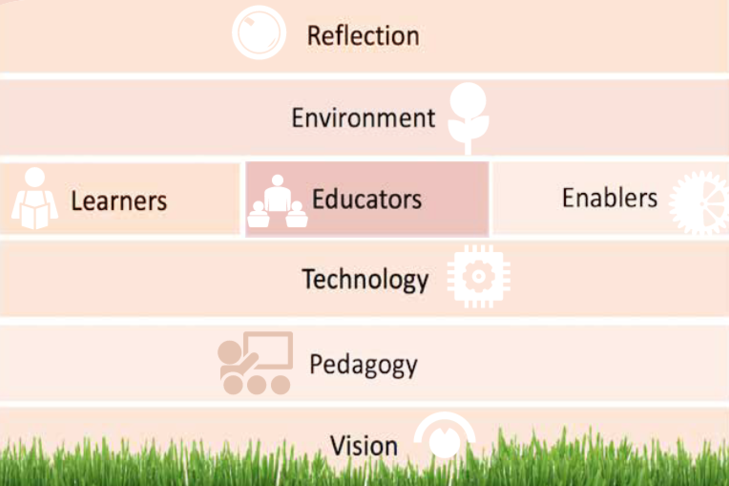Disruption and design
Myths, hype and reality in online education
From people to pedagogy
1.13 Selecting pedagogies and technologies

Supporting the use of pedagogy and technology © Commonwealth of Learning
Education using online tools offers opportunities for connecting learners and learning experiences, exploring the world, accessing new reference sources, personalising interactions, and sharing work outside the classroom. However, innovations that are led by technology often have little to offer learners other than the excitement of using a new tool. At the same time, as the Covid lockdowns made obvious, taking a pedagogy designed for one situtation (a classroom) and using it unchanged in a very different situation (a technology-enabled online class) often fails. Technology, pedagogy and context are entangled (Fawns, 2022) and all need to be taken into account when planning.
The image above is based on work that investigated which elements are associated with an successful innovation in technology-enhanced learning (Scanlon et al, 2013). A vision of the future provides a strong basis, followed by thoughtful consideration of both pedagogy and technology. Different groups of people, and the educational environment, can either support or obstruct change (Ferguson, 2019).
Successful online education is motivated by a vision of what is to be achieved. This might be a change in how learners feel, for example ‘In a year’s time, all our learners will be confident about presenting work to an audience’. It might be a change in how learners behave: ‘Next year, students will be aware of and use effective study techniques’. Or it might be a change in cognition: ‘All pupils in Year 5 will know what the scientific method is and be able to apply it to their own inquiries’. In each case, the vision is about learners and learning.
The next step is to put the building blocks of technology and pedagogy in place. Which approaches and tools will be most effective in achieving that vision? Even for an online educator, the tools will not necessarily be digital – sometimes paper and pencil or face-to-face discussion may be all that is needed. Multiple types of pedagogy are possible online – some examples are given in the table below.
| Learning method | Activity |
|---|---|
| Assessing | Engage in online peer review |
| Browsing | Use search engines to find resources |
| Collaborative | Work together on shared Google doc |
| Conversational | Discuss issues in a forum |
| Delivered | Listen to podcast or watch video |
| Inquiry driven | Use digital tools to collect and analyse data |
| Performative | Blog about their learning |
| Reflective | Review portfolios of activities |
Table 1. Learning methods and technology-based examples (based on work by Sharples, 2019)
A successful online experience requires engagement from different groups. At the most basic level, it’s important to make sure that both learners and educators have the skills necessary to access and use the required technology. Support staff can help by installing or upgrading hardware and software, and providing training where necessary. Managers develop policies that can support (or block) online learning initiatives, as well as approving expenditure on equipment and infrastructure. Some attention to the environment is also important, to ensure that equipment is available, updated and fully charged.
A final stage of implementation is reflection. Did the online learning experience achieve the desired effect? Is there a need to modify the experience in future, or your original vision? Were the technology and pedagogy good choices, was everybody well prepared, and was the environment set up to support learners? Pausing for thought can lead to developments and improvements, so that the initiatives that persist are the ones that have been shown to support learning.
© The Open University
